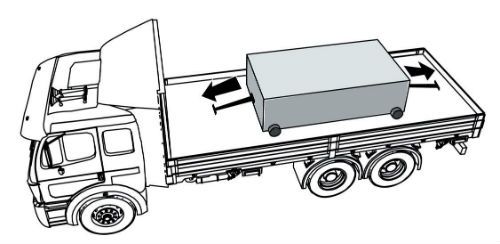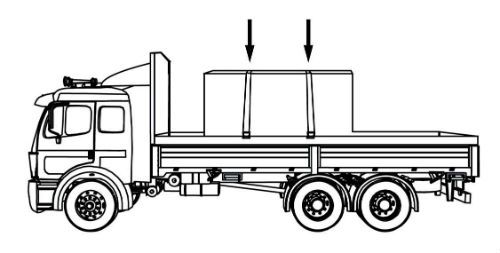CDL Practice Tests: Flatbed Cargo Securement
Choose A Section:
Go!When securing metal coils, it is acceptable to use nailed blocking or cleats as the sole means to secure:
- Nailed wood cradles
- It is not acceptable.
- Timbers
- Chocks
The use of nailed blocking or cleats as the sole means to secure timbers, chocks or wedges, or a nailed wood cradle, is prohibited.
When securing concrete pipe with a diameter up to 45 inches loaded crosswise as a group, a crosswise tiedown should be used every how many feet?
- 6
- 3
- 15
- 10
As a group
Place lengthwise tiedowns over the group of pipes:
Either one 13 mm (1/2 in) chain or wire rope,
Or two 10 mm (3/8 in) diameter chain or wire rope
Place one crosswise tiedown for every 3.0 m (10 ft) of load length.

Either attach the side-to-side tiedown through a pipe
Or pass the tiedown over both front-to-back tiedowns between two pipes on the top tier.
In case of low friction between the cargo and deck, which of these is not a solution?
- Set the cargo on friction mats.
- Use some kind of blocking.
- Attach tiedowns to the cargo.
- Put something heavy on top of the cargo.
What should you use in low-friction situations?
When there is low friction between the cargo and the deck (for example, with snow, ice, sand, gravel, and oil):
- Use tiedowns attached to the cargo.
- Use a means to improve the friction such as friction mats or tiedown that pass over the cargo.
- Use blocking and tiedowns.
While driving, the freight must not:
- Interfere with the free movement of the driver's arms or legs.
- All of these things should be avoided.
- Obscure the driver's view ahead, left, or right.
- Prevent the exit of a person from the cab.
- Obscure the driver's view ahead or to the right or left sides (except for drivers of self-steer dollies).
- Interfere with the free movement of the driver's arms or legs.
- Prevent the driver's free and ready access to accessories required for emergencies. OR
- Prevent the free and ready exit of any person from the commercial motor vehicle's cab or driver's compartment.
The definition for "shortwood" identifies pieces that are no longer than:
- Half the length of the trailer.
- 16 ft
- The width of the road.
- 75 in
Shortwood
- Normally up to about 2.5 m (100 in) in length.
- No longer than 4.9 m (16 ft) in length.
-
Also called:
- Cut-up logs
- Cut-to-length logs
- Bolts
- Pulpwood
The term 'edge protector' refers to:
- A structure, device, or another substantial article placed against an article to prevent it from tipping that may also prevent it from shifting.
- A rail along the side of a vehicle that protects the side of the vehicle from impacts.
- A vertical barrier placed directly behind the cab of a tractor to protect the cab in the event cargo should shift forward.
- A device placed on the exposed edge of an article to distribute tiedown forces over a larger area of cargo than the tiedown itself, to protect the tie-down and/or cargo from damage, and to allow the tiedown to slide freely when being tensioned.
Edge protector:
A device placed on the exposed edge of an article to distribute tiedown forces over a larger area of cargo than the tiedown itself, to protect the tie-down and/or cargo from damage, and to allow the tiedown to slide freely when being tensioned.
What is the minimum WLL required of tiedowns securing loaded intermodal containers on non-chassis vehicles?
- 80% of the loaded weight of the container.
- It depends on the length of the container.
- 20% of the loaded weight of the container.
- 50% of the loaded weight of the container.
Secure each container to the vehicle by:
- Either chains, wire ropes, or integral devices that are fixed to all lower corners.
- Or crossed chains that are fixed to all upper corners.
- Or both.
Secure the front and rear of the loaded container independently.
Secure the four corners using tiedowns that are attached to the loaded container.
The tiedowns must have an aggregate working load limit of at least 50% of the loaded weight of the loaded container.
Attach each chain, wire rope, or integral locking device to the container in a manner that prevents it from becoming unfastened while in transit.
When loading and securing a boulder, it should be:
- Placed on the vehicle with its largest or flattest side down.
- Placed on symmetrical hardwood blocking that extends 3/4 of the length of the boulder.
- All of these are requirements.
- Supported on at least 2 pieces of 4in x 4in hardwood blocking, extending the full width of the boulder.
Requirements

Place each boulder on the vehicle with its flattest and/or largest side down.

Support each boulder on at least two pieces of hardwood blocking (at least 10 cm x 10 cm (4 x 4 in) that extend the full width of the boulder.
Place hardwood blocking pieces as symmetrically as possible under the boulder so they support at least 3/4 of the length of the boulder.
When securing paper rolls with eyes crosswise, which of the following can be used to prevent side-to-side shifting when there is more than 8 inches of space to the wall?
- Void fillers.
- Friction mats.
- Any of these methods are acceptable.
- Tiedowns.
Requirements for eyes crosswise: prevent rolls from shifting toward either wall
If there is more than a total of 203 mm (8 in) of space between the ends of a paper roll and other rolls or the walls of the vehicle, use one of these methods:
- Void fillers (such as honeycomb)
- Blocking
- Bracing
- Friction mats
- Tiedowns
What is the minimum requirement for securing roll-off and hook containers?
- One tiedown attached to both the vehicle chassis and the container chassis.
- All of these are acceptable.
- Two tiedowns installed lengthwise, each securing one side of the container to one of the vehicle's side rails.
- Two hooks, or an equivalent mechanism, securing both sides of the container to the vehicle chassis.
Secure to the rear of the vehicle with at least one of the following three mechanisms:
-
Rear Mechanism 1:
One tiedown attached to both the vehicle chassis and the container chassis.
-
Rear Mechanism 2:
Two tiedowns installed lengthwise, each securing one side of the container to one of the vehicle's side rails.
-
Rear Mechanism 3:
Two hooks, or an equivalent mechanism, securing both sides of the container to the vehicle chassis at least as effectively as the tiedowns in the two previous items.
About The Flatbed Cargo Securement CDL Manual
Studying the flatbed cargo securement CDL manual is not a requirement for getting your CDL permit or license. It is required knowledge for flatbed drivers.
Some questions you should be able to answer for flatbed cargo securement:
- What is the minimum Working Load Limit of a tiedown used to secure logs?
- What is the minimum weight of a shipment of paper rolls that would require specific securement requirements?
- When securing concrete pipe over 45 inches loaded crosswise, which direction must the tiedowns on the front half of the load run?
- What is a cab shield?
- When securing concrete pipe over 45 inches loaded crosswise, which direction must the tiedowns on the rear half of the load run?
- What is a dunnage bag?
- Who is responsible for inspecting securing devices and cargo within the first 50 miles?
- How many tiedowns are required on a stack of shortwood loaded crosswise?
- What is the minimum working load limit of each tiedown used to secure crushed or flattened vehicles?
- Define 'bolster'
- What is a hook-lift container?
- When a tiedown is attached directly to the cargo, what is the ideal angle where it attached to the vehicle?
What is a securing device?
Any device specifically manufactured to attach or secure cargo to a vehicle or trailer:
- Synthetic Webbing
- Chain
- Wire rope
- Manila rope
- Synthetic rope
- Steel strapping
- Clamps and latches
- Blocking
- Front-end structure
- Grab hooks
- Binders
- Shackles
- Winches
- Stake pockets
- D-rings
- Webbing ratchet
- Bracing
- Friction mat
What is a tiedown?
A combination of securing devices that forms an assembly that:
- Attaches cargo to, or restrains cargo on a vehicle.
- Is attached to anchor point(s).

Some tiedowns are attached to the cargo and provide direct resistance to restrain the cargo from movement.

Some tie-downs pass over or through the cargo. They create a downward force that increases the effect of friction between the cargo and the deck. This friction restrains the cargo.
 Related Cargo Securement Terms That Every Driver Should Know:
Related Cargo Securement Terms That Every Driver Should Know:
-
Tiedown:
A combination of securing devices which form an assembly that attaches cargo to, or restrains cargo on, a vehicle or trailer, and is attached to anchor point(s).
-
Contained:
Cargo is contained if it fills a sided vehicle, and every article is in contact with or sufficiently close to a wall or other articles so that it cannot shift or tip if those other articles are also unable to shift or tip.
-
Blocking:
A structure, device, or another substantial article placed against or around an article to prevent horizontal movement of the article.
How should tiedowns be attached?
Tiedowns can be used in two ways:
-
Attached to the cargo:
- Tiedowns attached to the vehicle and attached to the cargo.
- Tiedowns attached to the vehicle, pass through or aroundan article of cargo, and then are attached to the vehicle again.
-
Pass over the cargo:
- Tiedowns attached to the vehicle, passed over the cargo, and then attached to the vehicle again.
Tiedown placement:

Place the tiedown as close as possible to the spacer.
Position the tiedowns as symetrically as possible over the length of the article.

Position the tiedowns to preserve the integrity of the article.







 TT On Facebook
TT On Facebook